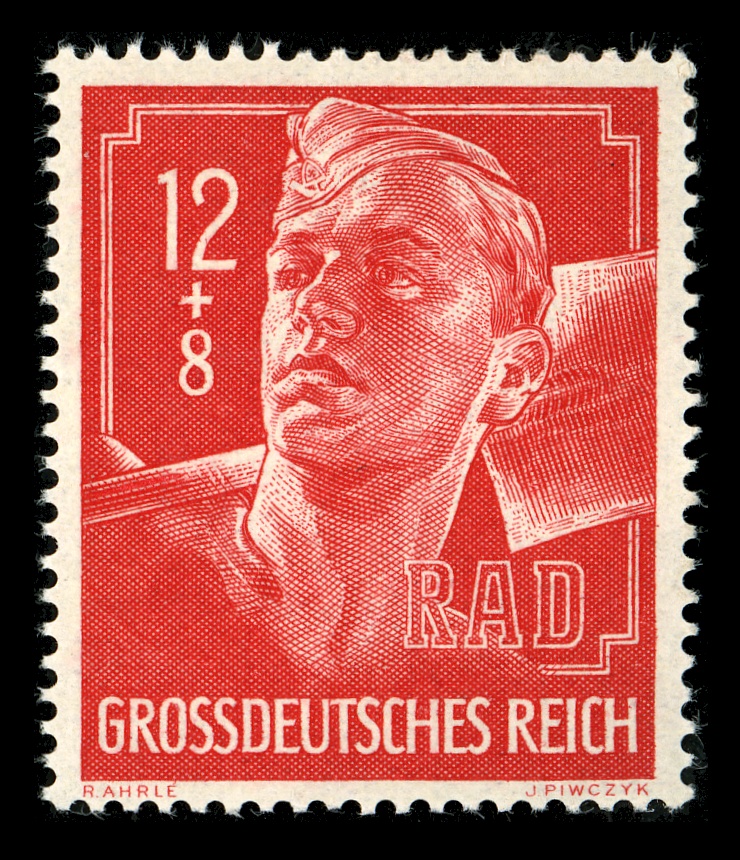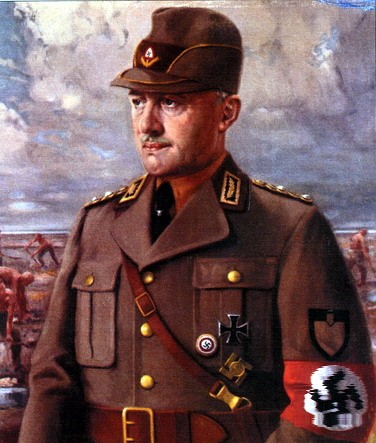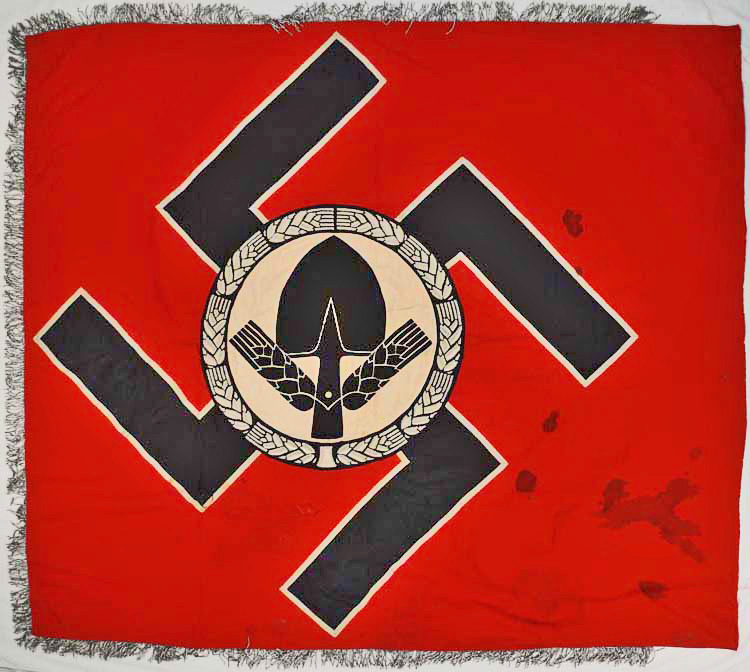


2eGM 1943 RAD Begriffsklärung Reichsarbeitsdiens M 43
English Translation
 |
Historique Voir ICI
History Click HERE
 |
| internet |
From 1932 until 1933, the FAD (Freiwilliger Arbeitsdienst- Voluntary Labor Service) wore a World War 1 period NCO or officer's visor cap with an earth-brown top piped in red, and a dark brown band. The visor was of the same color material with a raised protective ridge along its leading edge. The hat was generally worn with a leather chinstrap. However, on occasion, officers were noted wearing a silvered chincord with matching side buttons. NCO ranks wore a black leather chinstrap with metal fittings painted in black enamel. The insignia consisted of a standard cockade in the national colors (black-white-red). The center of this cockade was of red wool, bordered by an aluminum circle and having a serrated outer rim of black plastic or celluloid. This was pinned through the band and had centered above it the FAD badge-a spade flanked on each side by barley stalks. This badge was either of a silver color or made out of naturally colored aluminum metal.
In 1933, following the NSDAP'S assumption of power, the newly titled Labor Service (NS-Arbeitsdienst) introduced a more modern visor cap. This new cap had the traditional political pattern "saddle" form and consisted of a brownish blended woolen top and mounted on the center seam a silver metal-colored early style political eagle with black highlighted swastika. The hat band was of dark brown wool and had the national cockade pinned to its front. The piping colors matched either the top or the band depending on their location. The hat bill was in brown leather or fiber with the customary raised ridge along its edge. The whipcord indicated rank levels: a black Army-style leather chinstrap with lacquered metal fittings and side buttons was used to indicate ranks from Truppfuhrer to Oberstfeldmeister; a twisted silver whipcord was used for officers ftom Arbeitsfuhrer to Oberarbeitsfuhrer; and gilt chincord was used to designate the ranks of Arbeitsdienst-Inspektur to Staats-sekretar.
THE RAD "ROBIN HOOD" CAP
In 1933 a completely new type of cap was introduced for enlisted personnel and NCO ranks. It was a soft cap done in brownish blended wool, including the bill, and is often known as the "Robin Hood" cap. The hat body had a slight crease in the center of the crown and there were also creases in front of each of the sides, as well as a small circular metal air vent (sometimes two) in the hat body. The hat piping was the same color as the hat body and mounted along the leading edges of the cap's sides. The same piping, located approximately one inch (64 mm) from the edge of the visor, ran parallel to its leading edge. The hat band, in a darker brown wool was partially exposed where the side edges of the cap parted in the front.
The distinctive RAD "Robin Hood" service cap was designed by Reichsarbeitsführer Konstatin Hierl in 1934.
 |
 |
The new insignia used on this cap consisted of a redesign of the original FAD silver metal badge, ie. a shovel instead of a spade (superimposed on two barley shafts the latter flanking it on the left and right of the shovel,) The swastika was black with a white outline and the edges of the shovel were outlined in red.
The popularity and unique form of this cap in RAD ranks led to its adoption in 1935 by the officer personnel. Differences existed in both piping and emblem manufcture to designate officers from other ranks. The RAD badge remained the same for enlisted and NCO ranks up to the rank of Obertruppfuhrer, while officers' badges were enameled. After 1935, non-officer ranks also wore black piping on the bill and side panels. Officers from the ranks of Unterfeldmeister to Oberarbeitsfuhrer had silver aluminum piping and gilt was used for the ranks of Generalarbeitsfuhrer to Reichsarbeitsfuhrer.
The above style headdress could also feature the unit or traditional badges of the RAD, which could be worn by all rank levels and were issued in stamped metal or enamel and worn on the left side panel of the cap.
RAD facilities, as with most other political organizations, had their own guards or doorkeepers. The headdress of these personnel consisted of a visor cap with an earthbrown woolen top and a dark brown band and with no piping. They took an Army style black leather chinstrap with metallic fittings and buttons also painted the same color. The visor was of black fiber and the insignia was composed of a national cockade on the band and with the standard RAD emblem pinned through the center seam.
THE OVERSEAS CAP
The FAD style overseas cap was of a brown blend of wool with no piping and the only insignia, a national cockade.
Prior to the outbreak of the war, an overseas cap was used by personnel of the RAD which could be worn with the working as well as with the service uniforms. The standard RAD insignia of painted metal for enlisted ranks and enameled for officers was worn on the front of the cap where the side panels were joined. Tne piping colors were regulated by rank and ran the full length of the side edges of the cap. Black piping was used by ranks of Unterfeldmeister to Arbeitsmann: Oberstarbeitsfuhrer toFeldmeister ranks had silver piping; general officers adopted gilt piping.
THE RAD M-43 CAP
An Austrian forage or M-43 style hat of earth-brown wool was also used during the war years by all ranks of the RAD. Its piping color followed the organizational levels described above with regard to the overseas cap and encircled the entire paneled edge of the cap. The ear flaps were secured in the front of the cap by two aluminum pebbled metal buttons. The RAD insignia was centered above the buttons on the upper cap body.
RAD FEMALE HEADDRESS
During the war, all female members of the RAD wore a brimmed hat of blended brown felt. The band was of a light grey silk to which was pinned an insignia consisting of a swastika superimposed on two barley stalks and circled by an oval. This emblem was silver-colored aluminum for lower ranks and gilt for officers.